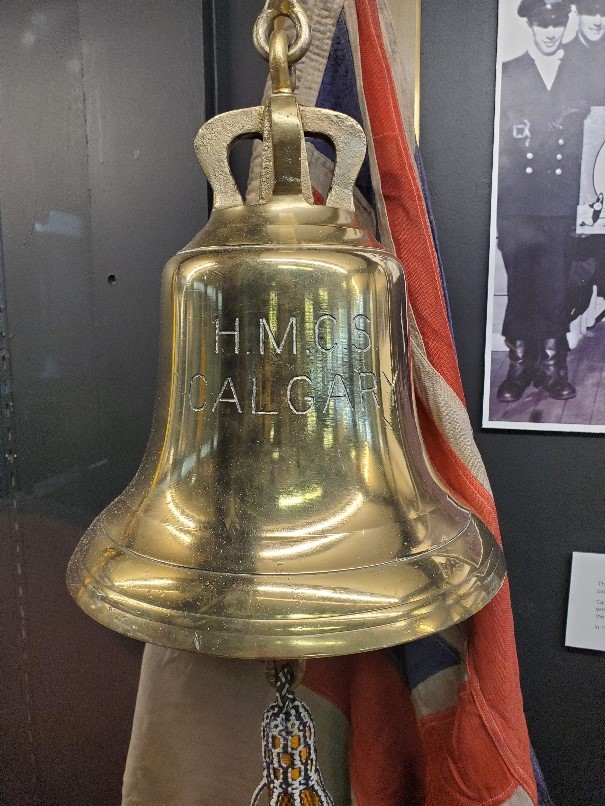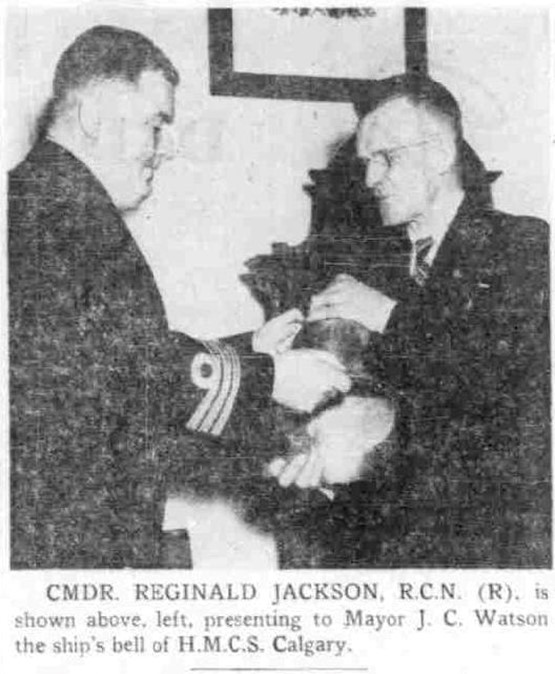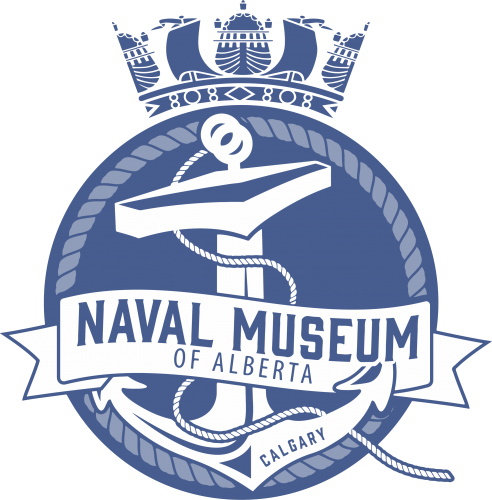HMCS Calgary's Bell
February 8th 2023
Those who know the Naval Museum of Alberta know that the ship’s bell from the original HMCS Calgary (K231) is on exhibit in the gallery with a model of the ship, and a White Ensign that flew on her. Adjacent to her are models of the current HMCS Calgary (FFH 335) in her original and post-DELEX configuration.
Recently, an article from the Calgary Herald from 11 June 1947 emerged, describing how the bell was presented to the Mayor of Calgary at City Hall. Following is a transcription of the article, which was copied as per the original, with some changes for clarification in square brackets.
The bell was presented to Mayor J.C. Watson by Commander Reg. Jackson OBE VD [VRD] RCN at the opening of Tuesday’s city council meeting. [CDR] Jackson was attended by Lieut. H.S. Squire, staff officer of HMCS Tecumseh.
[CDR] Jackson presented the bell to the city on behalf of the service as a token of appreciation for services rendered by the men who served aboard the ship by the Calgary citizens. A scroll accompanied the bell.
The mayor, in taking the bell, said it would be treasured long in memory of the brave men of the senior service.
[CDR] Jackson told the story of HMCS Calgary saying it was a warship whose history most nearly summed up the epic Battle of the Atlantic. It was launched at Sorel Que. Aug. 31, 1941, and was commissioned the following December. Nearly four years later, June 12, 1945, it was paid off and turned over to War assets for disposal.
THE CALGARY helped escort convoys to Britain and Gibraltar. She took part in two invasions, was a victor in one U-Boat encounter and possibly in others. She rescued torpedoed merchant ship survivors and on one occasion rescued three survivors of a U-Boat she helped destroy.
In May 1942, she attacked and damaged a submarine off eastern Canada. In July 1943 she picked up the crew and passengers of a torpedoes merchant ship from her convoy and landed then at Halifax. Her most exiting escort trip came in November of 1943 when travelling with a big convoy on a southerly Atlantic route. An aircraft located a submarine just ahead of the convoy at dawn and the Calgary dashed up to attack it but was unable to find it. A few hours later, a second submarine was detected and attacked. A periscope broke the surface and nises were heard indicating a U-Boat went down.
ATTACKS continued throughout the day and night. The Calgary and HMCS Snowberry came upon two subs on the surface. One submerged and the other fled away on the surface. German aircraft began to shadow the convoy but were driven off.
Four days after the first attack U-Boats closed in again at night and the Canadian corvettes with the help of star-shells and depth charges brought one to the surface and blasted it to pieces with their guns. Of a crew of 55 only 18 were rescued from this sub, three being picked up by the Calgary.
On the evening of Nov. 21 more U-boats attacked, and more battles ensued. Final score of the long-drawn-out battle was one submarine destroyed, two probably destroyed, and three other attacked with unknown results.
When the ships were about 600 miles off Gibraltar German airplanes attacked with glider bombs. HMCS Prince Robert, Canadian anti-aircraft cruiser, joined the convoy at this stage and entered the battle. R.A.F. Coastal Command planes also joined in. The enemy were beaten, and the convoy reached Gibraltar without loss of a ship, only two being damaged. The British press referred to this as one of the greatest air-sea battles of the war.
After her Normandy invasion duties ended, the Calgary went on cross-channel escort duty and at Sheerness, March 1945, she was rammed by a tank landing ship and returned to Canada for permanent repair which was incomplete when the war ended.
A motion by Aid George Brown to provide a glass exhibition case for the ship’s bell was adopted by the council.
Recently, an article from the Calgary Herald from 11 June 1947 emerged, describing how the bell was presented to the Mayor of Calgary at City Hall. Following is a transcription of the article, which was copied as per the original, with some changes for clarification in square brackets.
Corvette’s Bell Presented to City
The brass bell which rode out the battle of the Atlantic and the invasion of Normandy below the bridge of the corvette HMCS Calgary was received into the hands of the city Tuesday to repose permanently in a place of honour in the city hall public lobby.The bell was presented to Mayor J.C. Watson by Commander Reg. Jackson OBE VD [VRD] RCN at the opening of Tuesday’s city council meeting. [CDR] Jackson was attended by Lieut. H.S. Squire, staff officer of HMCS Tecumseh.
[CDR] Jackson presented the bell to the city on behalf of the service as a token of appreciation for services rendered by the men who served aboard the ship by the Calgary citizens. A scroll accompanied the bell.
The mayor, in taking the bell, said it would be treasured long in memory of the brave men of the senior service.
[CDR] Jackson told the story of HMCS Calgary saying it was a warship whose history most nearly summed up the epic Battle of the Atlantic. It was launched at Sorel Que. Aug. 31, 1941, and was commissioned the following December. Nearly four years later, June 12, 1945, it was paid off and turned over to War assets for disposal.
THE CALGARY helped escort convoys to Britain and Gibraltar. She took part in two invasions, was a victor in one U-Boat encounter and possibly in others. She rescued torpedoed merchant ship survivors and on one occasion rescued three survivors of a U-Boat she helped destroy.
In May 1942, she attacked and damaged a submarine off eastern Canada. In July 1943 she picked up the crew and passengers of a torpedoes merchant ship from her convoy and landed then at Halifax. Her most exiting escort trip came in November of 1943 when travelling with a big convoy on a southerly Atlantic route. An aircraft located a submarine just ahead of the convoy at dawn and the Calgary dashed up to attack it but was unable to find it. A few hours later, a second submarine was detected and attacked. A periscope broke the surface and nises were heard indicating a U-Boat went down.
ATTACKS continued throughout the day and night. The Calgary and HMCS Snowberry came upon two subs on the surface. One submerged and the other fled away on the surface. German aircraft began to shadow the convoy but were driven off.
Four days after the first attack U-Boats closed in again at night and the Canadian corvettes with the help of star-shells and depth charges brought one to the surface and blasted it to pieces with their guns. Of a crew of 55 only 18 were rescued from this sub, three being picked up by the Calgary.
On the evening of Nov. 21 more U-boats attacked, and more battles ensued. Final score of the long-drawn-out battle was one submarine destroyed, two probably destroyed, and three other attacked with unknown results.
When the ships were about 600 miles off Gibraltar German airplanes attacked with glider bombs. HMCS Prince Robert, Canadian anti-aircraft cruiser, joined the convoy at this stage and entered the battle. R.A.F. Coastal Command planes also joined in. The enemy were beaten, and the convoy reached Gibraltar without loss of a ship, only two being damaged. The British press referred to this as one of the greatest air-sea battles of the war.
After her Normandy invasion duties ended, the Calgary went on cross-channel escort duty and at Sheerness, March 1945, she was rammed by a tank landing ship and returned to Canada for permanent repair which was incomplete when the war ended.
A motion by Aid George Brown to provide a glass exhibition case for the ship’s bell was adopted by the council.

Click to close

Click to close
